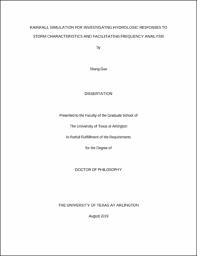
ATTENTION: The works hosted here are being migrated to a new repository that will consolidate resources, improve discoverability, and better show UTA's research impact on the global community. We will update authors as the migration progresses. Please see MavMatrix for more information.
Show simple item record
| dc.contributor.advisor | Fang, Zheng | |
| dc.creator | Gao, Shang | |
| dc.date.accessioned | 2020-08-04T17:17:12Z | |
| dc.date.available | 2020-08-04T17:17:12Z | |
| dc.date.created | 2019-08 | |
| dc.date.issued | 2019-08-06 | |
| dc.date.submitted | August 2019 | |
| dc.identifier.uri | http://hdl.handle.net/10106/29300 | |
| dc.description.abstract | Hydrologic and Hydraulic practices depend on the characterization of extreme precipitation that is rare in nature. Despite the advancement in sensing technology, the observation record of extreme rainfall with good spatio-temporal resolution has not reached a sufficient length. Furthermore, rainfall observation may never be sufficient in a non-stationary climate. Towards solutions to these issues, rainfall simulation was explored in this study (1) to investigate hydrologic responses to storm characteristics and (2) to facilitate rainfall frequency analysis. To that end, this study initially employed storm transposition plus hydrologic simulation for generating possible rainfall-runoff scenarios which further reveal relationships between storm characteristics and hydrologic responses from an urban watershed, Brays Bayou in Houston. Consequently, this study generated meaningful findings highlighting the role of Brays Bayou’s flat terrain in affecting flood peaks. Meanwhile, limitations in storm transposition were exposed and led to the development of a Dynamic Moving Storm (DMS) generator in the second part of this study. The DMS generator consists of three fundamental components, storm movement, spatial and temporal variabilities of rainfall intensity. By parameterizing each component, a vast variety of rainfall scenarios could be generated, simulated, and then analyzed again using Brays Bayou as the testbed. Hydrologic responses were revealed as results of not only individual parameters but also parameter interaction. The findings confirmed and augmented those based on the storm transposition approach. In accord with previous studies, storms moving downstream at the same velocity as streamflow were found to cause the resonance effect on flood peaks. Brays Bayou’s flat terrain was the key in explaining the patterns in various flood peaks and storm parameters. As the last part of this study, a stochastic storm generator was developed featuring optimal estimation for spatio-temporal modeling of rain fields and a non-parametric approach for generating model parameters. A case study in Dallas-Fort Worth Metroplex was conducted to generate possible realizations of 100 most rainy days at high spatio-temporal resolution. As the first step towards applying a long-term stochastic rainfall simulation, this approach was proved to offer many attractive traits, as statistical properties of observed rainfall were well preserved in simulations requiring only a small number of parameters. Collectively, this study offers innovative pathways for better utilizing rainfall information in flood modeling and rainfall frequency analysis with reduced uncertainties from the limited records of extreme storm events that make them feasible alternatives to traditional approaches. | |
| dc.format.mimetype | application/pdf | |
| dc.language.iso | en_US | |
| dc.subject | Rainfall simulation | |
| dc.subject | Storm transposition | |
| dc.subject | Deterministic storm generator | |
| dc.subject | Stochastic storm generator | |
| dc.subject | Hydrologic responses | |
| dc.subject | Rainfall frequency analysis | |
| dc.title | Rainfall Simulation for Investigating Hydrologic Responses to Storm Characteristics and Facilitating Frequency Analysis | |
| dc.type | Thesis | |
| dc.degree.department | Civil Engineering | |
| dc.degree.name | Doctor of Philosophy in Civil Engineering | |
| dc.date.updated | 2020-08-04T17:17:13Z | |
| thesis.degree.department | Civil Engineering | |
| thesis.degree.grantor | The University of Texas at Arlington | |
| thesis.degree.level | Doctoral | |
| thesis.degree.name | Doctor of Philosophy in Civil Engineering | |
| dc.type.material | text | |
| dc.creator.orcid | 0000-0001-8641-2433 | |
Files in this item
- Name:
- GAO-DISSERTATION-2019.pdf
- Size:
- 10.52Mb
- Format:
- PDF
This item appears in the following Collection(s)
Show simple item record


